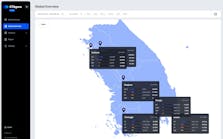Medical labs increase use of performance analytics; Target strategic IT investments
Digital transformation of processes and the resulting data and analytics generated are growing in importance across the healthcare industry, including medical laboratories.
To understand how medical laboratory professionals are using technology and data in their operations, Medical Laboratory Observer issued its third annual State of the Industry (SOI) survey on laboratory data analytics.
Three key findings:
1. The top strategic IT priorities for labs in the next three years are infrastructure and platform development, investment in new laboratory information system (LIS), and data analytics optimization to support lab management.
2. Increased use of data analytics for all aspects of lab management has grown, including areas such as performance measurement of turnaround times, quality improvement initiatives, test costs, and forecasting of test utilization.
3. Interoperability and data integration issues with laboratory information or electronic health record (EHR) systems remain a stumbling block to labs implementing electronic processes, with more than half of respondents citing this as a challenge.
Among those surveyed this year, the majority work in hospital laboratories (57%) and hold lab manager, administrator or supervisor positions (46%). Looking at lab size, 26% work in labs with 1-10 employees, 20% in labs with 11-20 employees, 22% in labs with 21-50 employees, 13% in labs with 51-100 employees, and 19% in labs with more than 100 employees.
For a broader industry perspective on the use of technology solutions in the clinical lab environment, MLO secured insights from solutions providers on the data and analytics trends they are seeing in the marketplace.
Note: This year’s survey included some new questions that were not asked and answer options not provided last year. Therefore, not every response has a 2023 comparison.
Information technology
Lab professionals were asked about their LIS platforms, electronic functions performed within these systems, and their lab’s near-term strategic IT priorities.
Compared with the results of the 2023 MLO SOI survey on laboratory data analytics, slightly more lab professionals reported using LIS modules within their enterprisewide EHR systems (65% in 2024 up from 61% in 2023), while fewer reported using stand-alone LIS systems (33% in 2024 down from 39% in 2023). The percentage of those using a cloud-based LIS infrastructure remained unchanged year over year (28%) while fewer reported using in-house software/servers (70% in 2024 down from 73% in 2023).
More labs are using their LIS systems for integration with analyzers (78% in 2024 up from 71% in 2023), electronic orders and results (91% in 2024 up from 87% in 2023), billing/revenue cycle management (60% in 2024 up from 56% in 2023), and customer service (16% in 2024 up from 15% in 2023).
Fewer lab professionals reported processing the following functions electronically in their LIS systems: regulatory compliance/reporting (22% in 2024 down from 31% in 2023), point-of-care test (POCT) management (30% in 2024, down from 34% in 2023), scheduling (29% in 2024 down from 31% in 2023), inventory control/supply chain management (15% in 2024 down from 17% in 2023), and quality assurance/quality control (51% in 2024 down from 52% in 2023).
As with last year’s survey, more than half of respondents (53%) reported interoperability and data integration issues with their LIS or EHR systems as a stumbling block to implementing electronic processes.
When asked for the top strategic IT priority for their organizations in the next three years, topping the list were infrastructure and platform development (23%), new LIS (which jumped to 21% in 2024 from 15% in 2023), and data analytics optimization to support lab management (19%). Ranking next highest was integration of the EHR system (12%), followed by revenue cycle management optimization (7%), and POCT product (2%).
Additionally, 13% of respondents chose “other” as their response, citing priorities including cybersecurity and the move to a cloud-based LIS system.
Jennifer Sanderson, MS, CTT+, MLS(ASCP)CM, Sr. Global Marketing Manager, Informatics and Services at Siemens Healthineers, commented on growing trend among lab professionals who want greater access to data from various sources. She stated:
“These professionals are interested in using the data for analytics and decision-making to drive operational efficiencies and improve the quality of care provided in their organizations. To achieve operational efficiency, labs have implemented data analytics programs such as Atellica Process Manager, which consolidates data from the LIS, middleware, and diagnostic equipment to improve resource management and optimize workflow.”
Testing volumes and tracking
When asked for the annual volume of testing performed by their lab, 26% of respondents reported processing between 1,000,001 to over 2,000,0000 tests (35% in 2023), 19% between 500,001 to 1,000,000 tests (16% in 2023), 21% between 100,001 to 500,000 (20% in 2023), and 25% 100,000 or fewer tests per year (29% in 2023).
The percentage of labs tracking the number of influenza tests increased (63% in 2024 up from 17% in 2023), as did the percentage of those tracking COVID-19 test numbers (72% in 2024, up from 54% in 2023).
Among the new conditions queried this year, 59% of lab professionals track the number of RSV tests, 46% the number of strep tests, and 40% the number of STI/HIV tests. An additional 11% said they track the number of tests for other conditions, including avian diseases, MRSA, hepatitis B, hepatitis C, and C. difficile, along with the basic metabolic panel (BMP), complete blood count (CBC), and comprehensive metabolic panel (CMP) tests.
Data analytics
Turning to data and analytics utilization, more lab professionals reported using data analytics for all aspects of lab management compared with last year (17% in 2024 up from 12% in 2023). Fewer respondents said they were utilizing data analytics for some aspects and planning more (36% in 2024 down from 49% in 2023). A lower percentage of respondents reported utilizing data analytics for some aspects and not planning more (10%).
Additionally, 22% of lab professionals surveyed said they have not used data analytics yet in any significant way but want to start (compared with 23% in 2023), and 12% said they were not using data analytics and have no plans to start in the near future.
Among those using data analytics in lab management, 54% reported using a tool integrated with their LIS systems (down from 69% in 2023), and 17% are using a separate tool (down from 31% in 2023). With regards to how often the data used for analytics is refreshed, 24% of respondents said their data was refreshed in real time (down from 31% in 2023), 19% daily (down from 28% in 2023), 14% weekly (down from 32% in 2023), 5% in hours (up from 3% in 2023), and 3% in minutes (down from 5% in 2023).
“Labs are generating more data across a variety of use cases (e.g., synoptic reporting, digital pathology, etc.) and technology has made this data more accessible for analysis,” said Stacia Sump, MS, MBA, Global Product Director, AI and Data Sciences, Clinisys. “Basic analytics is the starting point because it offers awareness and insight. As the old saying goes, ‘what gets measured gets improved.’ But this is just the beginning. Advanced analytics, including AI and ML capabilities, are starting to take hold in certain scenarios, such as digital pathology.”
KPIs
Topping the list of operational key performance indicators (KPIs) measured by the survey respondents’ labs were turnaround time (84% in 2024 up from 72% in 2023), quality improvement initiatives (71% in 2024), and cost per test (54% in 2024 up from 51% in 2023).
Those using KPIs to measure unnecessary tests increased from last year (23% in 2024 up from 16% in 2023), as did measurements of billable tests versus performed tests (40% in 2024 up from 35% in 2023) and medical necessity (37% in 2024 up from 33% in 2023). There was a drop in lab professionals reporting the use of KPIs to measure staff productivity goals (39% in 2024, down from 46% in 2023).
“Lab leaders need KPIs that will enable them to identify bottle necks and operate at peak efficiency without adding additional headcount,” Sump commented. “They need intelligence that proactively alerts them to problem areas that when addressed will give them the biggest bang for their buck, for instance, the same quality issue that has disrupted workflows 20 times.”
Sump also noted how clinical labs are often pressured to justify their existence and explained how utilization of data across disciplines can help lab leaders secure seats at their healthcare organizations’ executive tables.
“Clinisys is uniquely poised to assist here — providing one platform that unites multiple disciplines (e.g., anatomic and clinical pathology, molecular, toxicology, etc.) and reconciles data differences among these systems so they're all speaking the same language. This approach breaks down the silos that exist today, making it easier for lab leaders to participate in broader initiatives that are important to their organizations, such as research projects and population health management initiatives.”
Planning and forecasting
Turning to forecasting trends, most respondents do not use an electronic tool for management forecasting (69% in 2024, down from 75% in 2023), while nearly one-quarter said they do perform this task electronically (24% in 2024, down from 25% in 2023).
With regards to the types of management forecasting performed, there was a jump in reported test utilization forecasting compared with last year (66% in 2024, up from 46% in 2023), and a drop in staffing level forecasting (46% in 2024, down from 50% in 2023). Those lab professionals forecasting workloads decreased only slightly (53% in 2024, down from 54% in 2023). As for supply utilization, 36% of respondents reported forecasting of this measurement.
Survey respondents also reported on the challenges their organizations currently face or will face in the short-term in their planning and forecasting environment. Staffing challenges topped the list, with 76% of those surveyed ranking it a 1 or 2 on a scale of 1-5 (this was down from 85% in 2023). Funding ranked next highest on the list, with more than half (54%) of lab professionals ranking it a 1 or 2 on the 5-point scale (down from 56% in 2023).
The next most highly ranked planning and forecasting challenge was ROI/costs, garnering 21% of 1 or 2 rankings (down from 24% in 2023). This was followed by technology (18%) and training (13% in 2024 down from 19% in 2023).
hc1 Insights President Michael Braverman commented on the challenge of staffing issues and how technology solutions that use trained artificial intelligence (AI) models can empower lab leaders to “solve crucial operational problems.” He stated:
“We are seeing a growing trend from lab professionals who are challenged to get the right people in the right place at the right time and trying to find ways to pull data from their systems and use it to make confident, proactive decisions. Having the ability to easily justify staffing needs with dependable operations and financial data, precisely schedule staff by predicting demand for lab services across the organization and suggesting specific, department-level resource allocations, is a game changer when resources are scarce, and caregivers and patients are depending on you.”
Looking ahead
According to Sanderson, the increased desire among lab professionals to leverage data and analytics in their operations ultimately contributes to better patient care delivery and outcomes. She stated:
“The momentum toward data-driven decision-making in medical laboratories reflects a broader commitment to advancing healthcare through technology and analytics. As this trend continues to evolve, it promises to revolutionize how labs operate, contributing to a more efficient, precise, and patient-centered healthcare ecosystem.”
“Furthermore, laboratories are focusing on patient data analytics to optimize healthcare delivery,” she added. “They are looking to various sources to provide insights into patient data, aiding in more accurate testing protocols, more timely diagnoses and treatment decisions, and for use in predictive analytics that may help identify potential future health risks and enable preventive interventions.”












